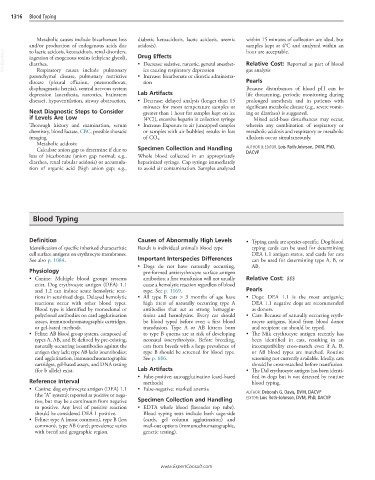Page 2600 - Cote clinical veterinary advisor dogs and cats 4th
P. 2600
1316 Blood Typing
Metabolic causes include bicarbonate loss diabetic ketoacidosis, lactic acidosis, uremic within 15 minutes of collection are ideal, but
and/or production of endogenous acids due acidosis). samples kept at 4°C and analyzed within an
VetBooks.ir ingestion of exogenous toxins (ethylene glycol), Drug Effects Relative Cost: Reported as part of blood
hour are acceptable.
to lactic acidosis, ketoacidosis, renal disorders,
diarrhea.
• Decrease: sedative, narcotic, general anesthet-
Respiratory causes include pulmonary
ics causing respiratory depression
parenchymal disease, pulmonary restrictive • Increase: bicarbonate or diuretic administra- gas analysis
disease (pleural effusion, pneumothorax, tion Pearls
diaphragmatic hernia), central nervous system Because disturbances of blood pH can be
depression (anesthesia, narcotics, brainstem Lab Artifacts life threatening, periodic monitoring during
disease), hypoventilation, airway obstruction. • Decrease: delayed analysis (longer than 15 prolonged anesthesia and in patients with
minutes for room temperature samples or significant metabolic disease (e.g., severe vomit-
Next Diagnostic Steps to Consider greater than 1 hour for samples kept on ice ing or diarrhea) is suggested.
if Levels Are Low [4°C]), excessive heparin in collection syringe Mixed acid-base disturbances may occur,
Thorough history and examination, serum • Increase: Exposure to air (uncapped samples wherein any combination of respiratory or
chemistry, blood lactate, CBC, possible thoracic or samples with air bubbles) results in loss metabolic acidosis and respiratory or metabolic
imaging of CO 2 . alkalosis occur simultaneously.
Metabolic acidosis:
Calculate anion gap to determine if due to Specimen Collection and Handling AUTHOR & EDITOR: Lois Roth-Johnson, DVM, PhD,
loss of bicarbonate (anion gap normal; e.g., Whole blood collected in an appropriately DACVP
diarrhea, renal tubular acidosis) or accumula- heparinized syringe. Cap syringe immediately
tion of organic acid (high anion gap; e.g., to avoid air contamination. Samples analyzed
Blood Typing
Definition Causes of Abnormally High Levels • Typing cards are species-specific. Dog blood
Identification of specific inherited characteristic Result is individual animal’s blood type typing cards can be used for determining
cell surface antigens on erythrocyte membranes. DEA 1.1 antigen status, and cards for cats
See also p. 1084. Important Interspecies Differences can be used for determining type A, B, or
• Dogs do not have naturally occurring, AB.
Physiology pre-formed antierythrocyte surface antigen
• Canine: Multiple blood groups systems antibodies; a first transfusion will not usually Relative Cost: $$$
exist. Dog erythrocyte antigen (DEA) 1.1 cause a hemolytic reaction regardless of blood
and 1.2 can induce acute hemolytic reac- type. See p. 1169. Pearls
tions in sensitized dogs. Delayed hemolytic • All type B cats > 3 months of age have • Dogs: DEA 1.1 is the most antigenic;
reactions occur with other blood types. high titers of naturally occurring type A DEA 1.1 negative dogs are recommended
Blood type is identified by monoclonal or antibodies that act as strong hemagglu- as donors.
polyclonal antibodies on card agglutination tinins and hemolysins. Every cat should • Cats: Because of naturally occurring eryth-
assays, immunochromatographic cartridges, be blood typed before even a first blood rocyte antigens, blood from blood donor
or gel-based methods. transfusion. Type A or AB kittens born and recipient cat should be typed.
• Feline: AB blood group system, composed of to type B queens are at risk of developing • The Mik erythrocyte antigen recently has
types A, AB, and B; defined by pre-existing, neonatal isoerythrolysis. Before breeding, been identified in cats, resulting in an
naturally occurring isoantibodies against the cats from breeds with a large prevalence of incompatibility cross-match even if A, B,
antigen they lack; type AB lacks isoantibodies; type B should be screened for blood type. or AB blood types are matched. Routine
card agglutination, immunochromatographic See p. 686. screening not currently available. Ideally, cats
cartridges, gel-based assays, and DNA testing should be cross-matched before transfusion.
(for b allele) exist. Lab Artifacts • The Dal erythrocyte antigen has been identi-
• False-positive: autoagglutination (card-based fied in dogs but is not detected by routine
Reference Interval methods) blood typing.
• Canine: dog erythrocyte antigen (DEA) 1.1 • False-negative: marked anemia
(the “A” system); reported as positive or nega- AUTHOR: Deborah G. Davis, DVM, DACVP
EDITOR: Lois Roth-Johnson, DVM, PhD, DACVP
tive, but may be a continuum from negative Specimen Collection and Handling
to positive. Any level of positive reaction • EDTA whole blood (lavender top tube).
should be considered DEA 1 positive. Blood typing tests include both cage-side
• Feline: type A (most common), type B (less (cards, gel column agglutination) and
common), type AB (rare); prevalence varies mail-out options (immunochromatographic,
with breed and geographic region. genetic testing).
www.ExpertConsult.com

